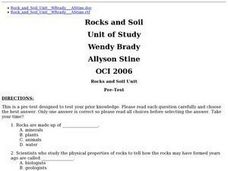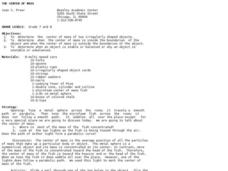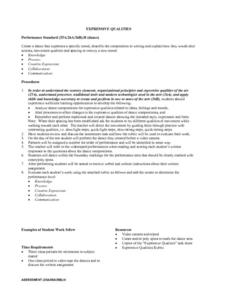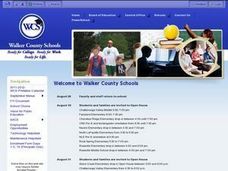Curated OER
Air Pollution
In this air pollution worksheet, students complete a crossword puzzle by reviewing the different types and sources of air pollution. This worksheet has 13 terms to place into the puzzle.
Curated OER
Ecological Footprint
Eighth graders discover their own ecological footprint and create a plan for reducing this figure. They extend this to the school and community to see how they are doing on this scale. They discuss the concept of the ecological...
Curated OER
The Water Cycle
In this water cycle worksheet, students learn about the 3 different stages of the water cycle: evaporation, condensation and precipitation. They then solve the 12 problems on the page. The answers are on the last page.
Curated OER
The Many Faces of Energy
In this energy instructional activity, students are given a table of the many measurements of energy. They solve 6 problems converting from one measurement of energy to another using the conversion factors given.
Curated OER
Pliable Proteins
Students make models of protiens using wire and paperclips. They are given step by step instructions with lots of information about proteins throughout the directions. They make the three basic structual elements of proteins;...
Curated OER
Rocks and Soil
Middle schoolers explore the physical properties of rocks. They explore the three different types of rocks and are able to compare and contrast their different properties. Students simulate the creation of sedimentary rock, they also...
Curated OER
Plant and Animal Cells: Alike and Different?
Seventh graders create a mneumonic device and a graphic organizer about the parts of plant and animal cells. In this biology lesson students are introduced to the parts of the cells and then work in groups to create projects that teach...
Curated OER
Missouri Time Scale and Earth Time Scale
In this time scale worksheet, students create a time scale of Missouri and the earth using adding machine tape. The length of the tape represents the history of Missouri and the history of earth. Students identify the major events in...
Curated OER
Mini-Ponds
For this mini pond worksheet, students create a mini-pond ecosystem with soil, water, and plant life. Students let their ecosystem sit for a day and they observe a sample the next day. Students identify all the pond water microorganisms...
Curated OER
Counting
In this counting worksheet, students practice counting from zero to ten. They trace the written version of each number four times and then practice writing it on their own on the line provided.
Curated OER
Integrating Chemistry-Chemical Reactions
For this chemical reactions worksheet, students read about different types of chemical reactions, potential and chemical energy. They answer three questions about their reading.
Curated OER
The Solar System: Go Green with the Sun!
Third graders learn how to use solar power. In this sun, technology and energy lesson, 3rd graders learn how the solar power from the sun can give off energy, learn about solar panels, discuss their uses and benefits, and design a...
Curated OER
The Center of Mass
Students determine the center of mass of two irregularly shaped objects, determine when the center of mass is inside or outside the boundaries of the object, determine when and/or why an object is stable, balanced, unstable or unbalanced.
Curated OER
Making Waves, Making Music, Making Noise
Students construct "talking cans" and instruments to explain how vibration of objects produces various sounds.
Curated OER
Performance Art and The Waste Stream
Students research local waste management services, discuss findings, give opinions about what they have found, offer solutions and ideas, and create performance art, design art works, and fine art works to convey information on waste...
Curated OER
Effects of Ozone in the Air
Fifth graders, in groups, conduct an experiment in which they measure ground level ozone levels using an ozone measuring kit. They analyze and compare the weather conditions and locations where ozone readings are highest and lowest.
Curated OER
Demonstrating the Distances of Stars
Students examine the distance from Earth to stars. They create a model to show the arrangement of constellations. They also identify the importance of the parallax effect.
Curated OER
Energy Detectives at Work
Students are "Energy Detectives" working for an engineering firm that does energy evaluations at schools. In teams, they locate energy sources around the school, and record their findings on an Energy Detective Worksheet.
Curated OER
EXPRESSIVE QUALITIES
Students create a dance that expresses a specific mood. They describe the composition in writing and explain how they would alter actions, movement qualities and spacing to convey a new mood. They perform the dance they created...
Curated OER
Plasma 101
Students examine the definitions and characteristics of plasma. After reading an article, they analyze new technologies to study plasma. In groups, they create a poster on how the different types of plasma work and write letters to their...
Curated OER
Reflecting on Reflectivity
Learners plan and construct a "mini-lab" to measure the reflectivity of different earth surfaces. They measure reflectivity of materials, including ice, soil, rocks, etc., and then extrapolate from what they have learned to consider the...
Curated OER
Make Acid Rain
Students create models of the earth's atmosphere to explore how gases that are dissolved in water can eventually create acid rain. After conducting a series of experiments within their models of the earth's atmosphere, students analyze...
Curated OER
Surface Area of a Leaf (Grades 7-9)
In this math and science activity, learners read about the process of photosynthesis and plant growth. They determine how a plant's ability to create food is dependent on the surface area of its leaves using geometric calculations. They...























